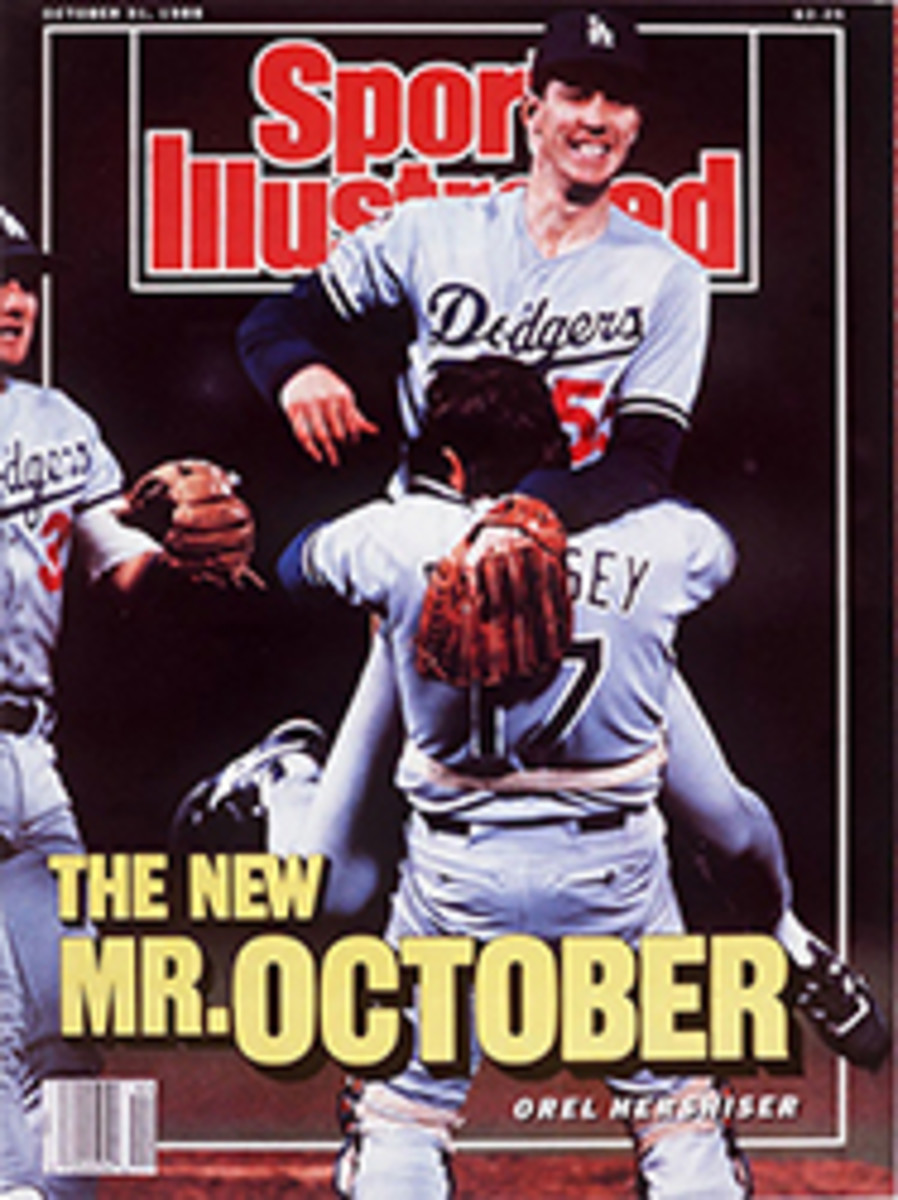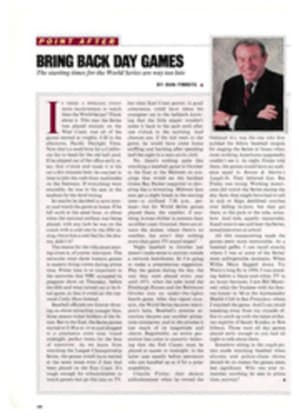
BRING BACK DAY GAMES
Is there a sporting event more inconvenient to watch than the World Series? Think about it. This year the Series was played entirely on the West Coast, and all of the games started at roughly 5:30 in the afternoon, Pacific Daylight Time. Now that's a swell hour for a California fan to head for the old ball yard. If he slipped out of the office early at, say, four o'clock and made it to his car a few minutes later, he was just in time to join the rush-hour multitudes on the freeways. If everything went smoothly, he was in his seat at the stadium by the third inning.
So maybe he decided to save money and watch the game at home. If he left work at the usual hour, or about when the national anthem was being played, with any luck he was on the couch with a cold one by the fifth inning. Gave him a real feel for the drama, didn't it?
The reason for the ridiculous starting times is, of course, television. The networks want those western games in eastern living rooms during prime time. Prime time is so important to the networks that NBC scrapped its pregame show on Thursday, before the fifth and what turned out to be final game, so that it could air the top-rated Cosby Show instead.
Baseball officials are forever droning on about attracting younger fans, those season-ticket holders of the future. But in the East, the Series games started at 8:30 p.m. or so and dragged to a conclusion some time 'round midnight, perfect hours for the fans of tomorrow. As we know from watching the League Championship Series, the games would have started at the same times even if they had been played on the East Coast. It's tough enough for schoolchildren to watch games that go this late on TV, but what East Coast parent, in good conscience, could have taken his youngster out to the ballpark knowing that the little nipper wouldn't make it back to the sack until after one o'clock in the morning. And chances are, if the kid went to the game, he would have come home sniffling and hacking after spending half the night in a near-arctic chill.
No, there's nothing quite like watching a baseball game in October in the East or the Midwest on evenings that would set the hardiest Green Bay Packer supporter to shivering like a bowstring. Midwest fans may get a slight break in the starting time—a civilized 7:30 p.m., perhaps—but for World Series games played there, the weather, if anything, is even chillier in autumn than on either coast. Granted, there are always the domes, where there's no weather, but aren't they nothing more than giant TV sound stages?
Night baseball in October just doesn't make sense to anyone outside a network boardroom. So I'm going to make a preposterous suggestion: Play the games during the day, the way they were played every year until 1971, when the tube lured the Pittsburgh Pirates and the Baltimore Orioles into an under-the-lights fourth game. After that signal occasion, the World Series became television's baby. Baseball's premier attraction became just another prime-time miniseries, and in the process it lost much of its magnitude and charm. Regrettably, an entire generation has come to maturity believing that the Fall Classic must be played at sunset or midnight, in the latter case usually before spectators who are bundled up as if for a polar expedition.
Charlie Finley, that demon schlockmeister when he owned the Oakland A's, was the one who first scolded his fellow baseball moguls for staging the Series at hours when most working Americans supposedly couldn't see it. At night, Finley told them, the games would have an audience equal to Rowan & Martin's Laugh-In. They believed him. But Finley was wrong. Working Americans did watch the Series during the day. Sure, they might have had to call in sick or feign deathbed watches over failing in-laws, but they got there, to the park or the tube, somehow. And kids, equally resourceful, found ways to see and hear the Series, sometimes even at school.
All this maneuvering made the games seem more memorable. As a baseball gaffer, I can recall exactly where I was at some of the Series' most unforgettable moments. When Willie Mays flagged down Vic Wertz's long fly in 1954, I was standing before a black-and-white TV in an Army barracks. I saw Bill Mazeroski whip the Yankees with his famous homer in '60 at the Ambassador Health Club in San Francisco, where I watched the game. And I can recall sneaking away from my cityside office to catch up with the latest strikeout exploits of Sandy Koufax or Bob Gibson. Those were all day games played early enough so you had all night to talk about them.
Somehow sitting in the couch-potato mode watching baseball when sitcoms and police-chase shows should be on makes the games seem less significant. Who can ever remember anything he sees in prime time, anyway?
PHOTO
CRAIG MOLENHOUSE

